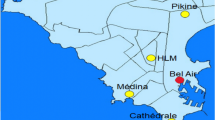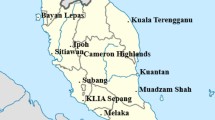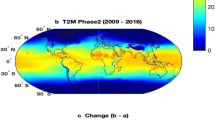Abstract
The main aim of this study is to develop a new model using the Gaussian distribution in global solar radiation estimation. In this study, a new global solar radiation (SR) model was developed using the Matlab program, and the performance of this developed model was examined in different regions. With this newly developed model, the estimated values were compared with the actual measured values in the determined regions. When the literature is examined, it is seen that although many different methods and approaches have been used in SR estimation, no model has been developed with the Gaussian distribution. Thus, the performance of this new developed model was observed in detail in different regions. The performance of the developed model was examined in six different statistical error tests. The developed new model was compared with twenty different models. Global SR data used in this study were obtained from the Turkish State Meteorological Service. When the results are evaluated in general, it has been observed that the Gaussian model exhibited the best performance with RPE = 0.3574, MPE = 0.7794, R2 = 0.9848, MAPE = 6.7525, SSRE = 0.0997, and t-stat = 0.1913 resulting in the amongst all the models which were compared. In addition to these results, it was observed that the performance of the new model developed gave acceptable results in different regions. The findings of this study are expected to make significant contributions to the growing literature on advancing forecasting model development efforts to predict solar energy production.






Similar content being viewed by others
Data availability
The datasets generated during and/or analyzed during the current study are available from the corresponding author on request.
Code availability
Not applicable.
Abbreviations
- μ:
-
Mean of global SR
- σ:
-
Variance of global SR
- S:
-
Sunshine duration
- S 0 :
-
Day length
- H :
-
Daily total SR
- H 0 :
-
SR coming out of atmosphere
- W s :
-
Hour angle
- ∅:
-
Latitude of the site
- δ :
-
Angle of solar declination
- I sc :
-
Solar constant
- mi:
-
Calculated value of SR
- c i :
-
Measured value of SR
- ma:
-
The mean calculated value of SR
- ca:
-
The mean measured value of SR
References
Ağbulut Ü, Gürel AE, Biçen Y (2021) Prediction of daily global solar radiation using different machine learning algorithms: evaluation and comparison. Renew Sust Energ Rev 135:110114
Akinoğlu BG, Ecevit A (1990) A further comparison and discussion of sunshine-based models to estimate global solar radiation. Energy 15(10):865–872
Aksoy B (1997) Estimated monthly average global radiation for Turkey and its comparison with observations. Renew Energy 10(4):625–633
Almorox JY, Hontoria C (2004) Global solar radiation estimation using sunshine duration in Spain. Energy Convers Manag 45(9):1529–1535
Alsaad MA (1990) Characteristic distribution of global radiation for Amman, Jordan. Sol Wind Technol 7:261–266
Aras H, Balli O, Hepbasli A (2006) Global solar radiation potential, Part 2: Statistical analysis. Energy Sources Part B-Economics Planning And Policy 1(3):317–326
Atluri SN, Zhu T (1998) A new meshless local Petrov–Galerkin (MLPG) approach in compu-tational mechanics. Comput Mech 22(1998):117–127
Bahel V, Srinivasan R, Bakhsh H (1986) Solar radiation for Dhahran, Saudi Arabia. Energy 11(10):985–989
Bilbao J, Román R, Yousif C, Mateos D, de Miguel A (2014) Total ozone column, water vapour and aerosol effects on erythemal and global solar irradiance in Marsaxlokk, Malta. Atmos Environ 99:508–518
Duffie JA, Beckman WA (2013) Solar radiation. Solar Engineering of Thermal Processes, Fourth Edition, pp 3–42
El Genidy M (2019) Multiple nonlinear regression of the Markovian arrival process for estimating the daily global solar radiation. Communications in Statistics-Theory and Methods 48(22):5427–5444
El Genidy MM, Abd El-Rahman DAE (2019) A New high accurate estimation method for evaluating the daily solar energy by nested percentiles algorithm. Asian Journal of Scientific Research 12(4):480–487
El Genidy MM, Beheary MS (2022) Forecasting methods in various applications using algorithm of estimation regression models and converting data sets into Markov model. Complexity 2022:1–20
El Genidy M, Megahed W, Mahfouz K (2022) Algorithms of solar energy prediction combined with percentile root estimation of three-parameters distributions. Appl Math 16(4):529–547
Fan J, Wu L, Zhang F, Cai H, Ma X, Bai H (2019) Evaluation and development of empirical models for estimating daily and monthly mean daily diffuse horizontal solar radiation for different climatic regions of China. Renew Sust Energ Rev 105:168–186
Feng Y, Hao W, Li H, Cui N, Gong D, Gao L (2020) Machine learning models to quantify and map daily global solar radiation and photovoltaic power. Renew Sust Energ Rev 118:109393
Guermoui M, Gairaa K, Rabehi A, Djafer D, Benkaciali S (2018) Estimation of the daily global solar radiation based on the Gaussian process regression methodology in the Saharan climate. The European Physical Journal Plus 133(6):1–17
Ikram RMA, Dai HL, Ewees AA, Shiri J, Kisi O, Zounemat-Kermani M (2022) Application of improved version of multi verse optimizer algorithm for modeling solar radiation. Energy Rep 8:12063–12080
Jamil B, Bellos E (2019) Development of empirical models for estimation of global solar radiation exergy in India. J Clean Prod 207:1–16
Jin Z, Yezheng W, Gang Y (2005) General formula for estimation of monthly average daily global solar radiation in China. Energy Convers Manag 46(2):257–268
Kaplan YA (2018) A new model for predicting the global solar radiation. Environ Prog Sustain Energy 37(2):870–880
Kaplan AG, Kaplan YA (2020) Developing of the new models in solar radiation estimation with curve fitting based on moving least-squares approximation. Renew Energy 146:2462–2471
Kaplan YA, Saraç MS, Ünaldı GG (2022) Developing a new model in solar radiation estimation with genetic algorithm method. Environ Prog Sustain Energy 41(6):e13912
Katiyar AK, Pandey CK (2010) Simple correlation for estimating the global solar radiation on horizontal surfaces in India. Energy 35(12):5043–5048
Khorasanizadeh H, Mohammadi K, Mostafaeipour A (2014) Establishing a diffuse solar radiation model for determining the optimum tilt angle of solar surfaces in Tabass. Iran Energy Conversion and Management 78:805–814
Li H, Ma W, Lian Y, Wang X, Zhao L (2011) Global solar radiation estimation with sunshine duration in Tibet, China. Renew Energy 36(11):3141–3145
Louche A, Notton G, Poggi P, Simonnot G (1991) Correlations for direct normal and global horizontal irradiation on a French Mediterranean site. Sol Energy 46(4):261–266
Makade RG, Chakrabarti S, Jamil B, Sakhale CN (2020) Estimation of global solar radiation for the tropical wet climatic region of India: a theory of experimentation approach. Renew Energy 146:2044–2059
Mecibah MS, Boukelia TE, Tahtah R, Gairaa K (2014) Introducing the best model for estimation the monthly mean daily global solar radiation on a horizontal surface (Case study, Algeria). Renew Sust Energ Rev 36:194–202
Menges HO, Ertekin C, Sonmete MH (2006) Evaluation of global solar radiation models for Konya, Turkey. Energy Convers Manag 47(18):3149–3173
Notton G, Voyant C, Fouilloy A, Duchaud JL, Nivet ML (2019) Some applications of ANN to solar radiation estimation and forecasting for energy applications. Appl Sci 9(1):209
Oztürk M, Ozek N, Berkama B (2012) Comparison of some existing models for estimating monthly average daily global solar radiation for Isparta. Pamukkale University Journal of Engineering Sciences 18(1):13–27
Page JK (1961) The calculation of monthly mean solar radiation for horizontal and inclined surfaces from sunshine records for latitudes 40N-40S. UN conference on new sources of energy 4:378–390
Qin W, Wang L, Lin A, Zhang M, Xia X, Hu B, Niu Z (2018) Comparison of deterministic and data-driven models for solar radiation estimation in China. Renew Sust Energ Rev 81:579–594
Rahimi I, Bakhtiari B, Qaderi K, Aghababaie M (2012) Calibration of Angstrom equation for estimating solar radiation using Meta-Heuristic harmony search algorithm (Case study, Mashhad-East of Iran). Energy Procedia 18:644–651
Raja IA, Twidell JW (1990) Diurnal variation of global insolation over five locations in Pakistan. Sol Energy 44(2):73–76
Salcedo-Sanz S, Deo RC, Cornejo-Bueno L, Camacho-Gómez C, Ghimire S (2018) An efficient neuro-evolutionary hybrid modelling mechanism for the estimation of daily global solar radiation in the Sunshine State of Australia. Appl Energy 209:79–94
Salhi H, Belkhiri L, Tiri A (2020) Evaluation of diffuse fraction and diffusion coefficient using statistical analysis. Appl Water Sci 10(6):1–12
Salhi H, Hadjira A, Jamil B (2021) Statistical analysis of the solar diffuse fraction radiation using regression analysis of longitudinal data in India.
Samuel TDMA (1991) Estimation of global radiation for Sri Lanka. Sol Energy 47(5):333–337
Skeiker K (2006) Correlation of global solar radiation with common geographical and meteorological parameters for Damascus province, Syria. Energy Convers Manag 47(4):331–345
Srivastava RC, Pandey H (2013) Estimating Angstrom–Prescott coefficients for India and developing a correlation between sunshine hours and global solar radiation for India. Renew Energy 1:11–17
Tiris M, Tiris C, Erdalli Y (1997) Water heating systems by solar energy. In: Marmara Research Centre, Institute of Energy Systems and Environmental Research. Nato Tu-Coating, Gebze, Kocaeli, Turkey
Togrul INT, Onat E (2000) A comparison of estimated and measured values of solar radiation in Elazig, Turkey. Renew Energy 20(2):243–252
Togrul IT, Togrul H, Evin D (2000) Estimation of monthly global solar radiation from sunshine duration measurement in Elazig. Renew Energy 19(4):587–595
Ulgen K, Hepbasli A (2002) Determination of Weibull parameters for wind energy analysis of Izmir, Turkey. Int J Energy Res 26(6):495–506
Ulgen K, Hepbasli A (2004) Solar radiation models. Part 2: comparison and developing new models. Energy Sources 26(5):521–530
Üstün İ, Üneş F, Mert İ, Karakuş C (2022) A comparative study of estimating solar radiation using machine learning approaches: DL, SMGRT, and ANFIS. Energy Sources, Part A: Recovery, Utilization, and Environmental Effects 44(4):10322–10345
Yang WY, Cao W, Tae SC, Moris J (2005) Applied numerical methods using MATLAB. John Wiley & Sons
Yildiz M, Oz S (1994) Evaluation of the solar energy potential of Turkey. In Proceedings of the 6th National Energy Congress, pp 250–260
Yohanna JK, Itodo IN, Umogbai VI (2011) A model for determining the global solar radiation for Makurdi, Nigeria. Renew Energy 36(7):1989–1992
Zang H, Cheng L, Ding T, Cheung KW, Wang M, Wei Z, Sun G (2019) Estimation and validation of daily global solar radiation by day of the year-based models for different climates in China. Renew Energy 135:984–1003
Author information
Authors and Affiliations
Contributions
Y.A.K. organised: Conceptualization, Writing- Reviewing and Editing A.G.K. prepared Writing- Reviewing and Editing. Y.A.K. and A.G.K. wrote the main manuscript text.
Corresponding author
Ethics declarations
Ethics approval
Not applicable.
Consent to participate
Not applicable.
Consent for publication
Not applicable.
Competing interests
The authors declare no competing interests.
Additional information
Publisher’s Note
Springer Nature remains neutral with regard to jurisdictional claims in published maps and institutional affiliations.
Rights and permissions
Springer Nature or its licensor (e.g. a society or other partner) holds exclusive rights to this article under a publishing agreement with the author(s) or other rightsholder(s); author self-archiving of the accepted manuscript version of this article is solely governed by the terms of such publishing agreement and applicable law.
About this article
Cite this article
Kaplan, Y.A., Kaplan, A.G. A new approach for estimating solar radiation using Gaussian distribution and developing new model. Theor Appl Climatol 155, 1007–1017 (2024). https://doi.org/10.1007/s00704-023-04675-y
Received:
Accepted:
Published:
Issue Date:
DOI: https://doi.org/10.1007/s00704-023-04675-y




